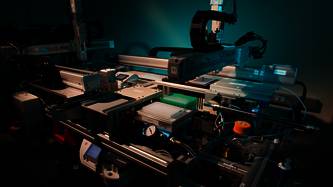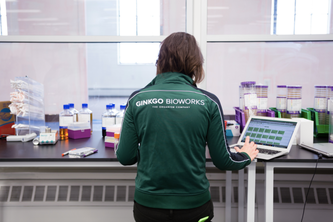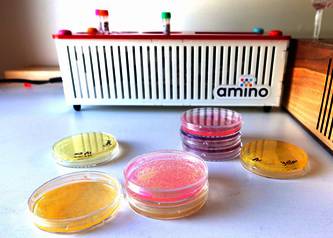Future Now
The IFTF Blog
Food Innovation Recipes: EXPERIMENTAL BIODESIGN
Some recipes are passed down from generation to generation, becoming long-standing traditions. Others invite us to explore new regions or inspire us to reinvent our bodies. They even encourage us to reimagine the food spaces in our lives, from our kitchens to our marketplaces. The power of recipes is the power to combine ingredients in novel ways.
 As we look at the complex global threats we face over the coming decade, from environmental disasters to income inequality to political conflict, we must consider what Institute for the Future calls ingredients for change—capacities, tools, and platforms to reinvent food experiences with the greatest potential for transformation.
As we look at the complex global threats we face over the coming decade, from environmental disasters to income inequality to political conflict, we must consider what Institute for the Future calls ingredients for change—capacities, tools, and platforms to reinvent food experiences with the greatest potential for transformation.
This post gives an overview of one of these ingredients: experimental biodesign. Read more about all five in our forecast report, Food Innovation: Recipes for the Next Decade.
Experimental Biodesign:
Toward reinventing food experiences and food systems
Culinary artists and scientists have always experimented with the tools of their disciplines to develop new foods. Louis Pasteur’s fascination with fermentation is just one example of humans’ longstanding curiosity about the processes of cooking and preserving food. In more recent years, the proliferation of research labs that combine the culinary arts with food science, such as The Cooking Lab from the authors of Modernist Cuisine, has expanded the scope and pace of food innovation. And as synthetic biology evolves, new capacities at the intersection of culinary arts and food science and technology will accelerate the design of new flavors, food experiences, and food systems.
The convergence of two drivers of change will enable experimental biodesign as an ingredient for food innovation over the next decade. First, an emerging effort to integrate biological systems with design—biodesign—seeks to create more robust and resilient systems by harnessing living organisms’ “tremendous power and potential utility [and] natural interaction,” in the words of design historian William Meyers. Biological building blocks like microbes have always been in our food, but as we gain better understanding of their functions, we will be better able to manipulate these building blocks to reinvent food experiences.
 Second, synthetic biology—the ability to redesign the biological building blocks themselves—will expand the scope of biodesign for food. Synthetic biology uses advanced science and engineering to make living organisms by writing new genetic code. This is happening with increasing speed and ease. For instance, Harvard University’s Wyss Institute for Biologically Inspired Engineering built a machine that uses natural evolution principles to generate billions of different genomes in a day, dramatically reducing the time and effort required to create genomes with desired properties for organism design.
Second, synthetic biology—the ability to redesign the biological building blocks themselves—will expand the scope of biodesign for food. Synthetic biology uses advanced science and engineering to make living organisms by writing new genetic code. This is happening with increasing speed and ease. For instance, Harvard University’s Wyss Institute for Biologically Inspired Engineering built a machine that uses natural evolution principles to generate billions of different genomes in a day, dramatically reducing the time and effort required to create genomes with desired properties for organism design.
Taken together, biodesign and synthetic biology—the integration of living organisms as building blocks into larger systems, and the ability to make those building blocks with specific properties—create a platform for innovating rapidly, iteratively, and with an ecological perspective. Over the next decade, experimental biodesign will expand our potential to create new flavors and food experiences with systems-level impacts. We’ll see new relationships among scientists, chefs, designers, and biohackers as the tools become more accessible. And as we experiment at the level of biological building blocks, we will reorient our paradigms toward cellular food systems—building from the organism up. This raises an imperative to think about where this rapidly changing technology will intersect not just with our food system but also with our values.
We’ve developed three forecasts for how experimental biodesign will unfold as an ingredient for innovation in the next decade, with signals of change from today.
FORECAST: precision flavor
From culinary intuition to engineering
Chefs have traditionally relied on time-tested recipes, secret ingredients, and culinary intuition to create delicious foods with complex flavors. Over the next decade, we will gain faster, more dynamic ways to quantify, engineer, and invent flavors. Already chefs are beginning to augment their understanding of flavor at the molecular level, building their own tools for tracking flavor metrics to ensure intended outcomes. Synthetic biologists are engineering yeast to produce flavors—and potentially create new or revive lost flavors—that can be labeled as natural. As appetites for artificial flavors shift, the ability to quickly prototype and design new organism-derived flavors may become more attractive. But there are pitfalls to this approach; early consumer protests over cultured flavors indicate that we will need to reconsider our intentions for engineering and using living organisms as our capabilities expand.
We can see these possibilities through the lens of several signals:
Signal: An umami meter created at the Noma culinary lab in Copenhagen uses a simple Arduino-powered sensor and LED light to measure free glutamate, a proxy for umami—a basic taste that gives savory depth to food. This analysis normally requires an expensive spectrophotometer. The meter prototype points to a future in which chefs will leverage cheap technology and molecular indicators to quantify flavor and build precise recipes.

 Signal: Ginkgo Bioworks is one of several companies engineering yeast to produce synthetic flavors that can be labeled as natural; the final flavors don’t include the engineered yeast (which is filtered out), so they contain no genetically modified organisms. Ginkgo’s organism designers use robotics and automated systems to design and analyze microbes at industrial scale.
Signal: Ginkgo Bioworks is one of several companies engineering yeast to produce synthetic flavors that can be labeled as natural; the final flavors don’t include the engineered yeast (which is filtered out), so they contain no genetically modified organisms. Ginkgo’s organism designers use robotics and automated systems to design and analyze microbes at industrial scale. - Signal: In 2014, advocacy group Friends of the Earth launched a campaign against vanillin produced with synthetic biology, spurring ice cream brands to announce their products will never contain cultured vanillin. Critics called the campaign misplaced, since synthetic vanillin produced from petrochemicals has been used commercially for nearly a century. The introduction of synthetic biology into the food system is likely to lead to similar consumer protests and calls for transparency.
FORECAST: multidimensional food experiences
From static to dynamic food and packaging
The same tools that are reinventing flavor are expanding the scope of bio-based experimentation across many dimensions of our food experiences, from textures to packaging to multisensory stimulation. Innovators are using the same culturing methods as flavor engineers to produce early prototypes of animal proteins derived from engineered yeast. In the longer term, we can imagine designing foods with new textures, functions like elasticity, or the ability to express properties over time. Beyond food itself, the fashion and materials industries are designing living materials that will potentially enable packaging with new functionalities. These early experiments point to a future in which we’ll harness the natural dynamics of living organisms for more dynamic food experiences.
The signals below hint at the ways in which synthetic biology will unleash new ways to manufacture food and packaging:
Signal: Clara Foods is one of several start-ups harnessing yeast to prototype cultured animal proteins. It aims to produce egg whites with a more dynamic set of properties than animal egg whites, such as a more complete protein profile and increased foam stability for meringues and other baked goods. Other startups are focused on fermenting dairy products from yeast, such as The Real Vegan Cheese Project, an open-source effort from a community biology lab, and Perfect Day.
Signal: Living Food is a speculative design project from London-based artist Minsu Kim that explores a future in which synthetic biology creates new kinds of human-food interactions and multisensory stimulation. Kim portrays dining experiences where food behaves like a living creature, inviting us to imagine further possibilities for novel eating experiences and also foods that are designed to change over time, perhaps to curb spoilage.
Signal: Biocouture founder Suzanne Lee designed clothes using a biomaterial that was fermented by a mix of bacteria and yeast. Experimental biodesigners like Lee imagine microbes will be the factories of the future, accelerating a materials revolution that is also being helped along by synthetic biology that enables the programming of bacteria to produce materials with specific qualities. Grown materials could have new sensing capabilities and functionalities that could be incorporated in food packaging.
FORECAST: cellular food systems
From extractive to cultured food
Redesigning the biological building blocks of food will reshape food systems. Scientists are experimenting with synthetic biology to reprogram biological systems of plants, not just microbes, for effects like improved nitrogen fixing. The innovators pioneering cultured flavors and proteins plan to scale quickly to overcome the environmental constraints, animal welfare concerns, and lack of food affordability in today’s extractive food systems. Others are building advocacy campaigns and do-it-yourself platforms to build public literacy about synthetic biology—to shift food cultures toward cultured food. Biodesigners who seem experimental today may not be so experimental in ten years—even cultured beef is expected to be on the market within the next decade, according to Mark Post, who led the team that developed the first cultured hamburger. As these foods become available, we will wrestle with new elements of the already complex environmental, political, and ethical dimensions of our food system.
The following signals point to a future in which synthetic biology opens new pathways for designing not just individual foods, but also reimagining food systems:
Signal: The OpenPlant Synthetic Biology Research Centre among the University of Cambridge, the John Innes Centre, and the Sainsbury Laboratory aims to reprogram entire biological systems of plants, not just microbes, for sustainable agriculture, bioproduction, and improved land use. It hopes to introduce plant traits ranging from new forms of symbiosis and nitrogen fixing to improved leaf structure, while promoting responsible innovation and open exchange among scientists. In September 2017, the organization published a handbook outlining project progress, research, and guidelines for fostering innovation.
Signal: New Harvest is a U.S.-based nonprofit that is advancing the “post-animal bioeconomy.” Powered by donations, the organization has helped channel more than two million dollars to efforts that are developing cultured beef, eggs, and milk. It also fosters dialogue and education across the scientific community, entrepreneurs, investors, and the public.

Signal: Created by the MIT Media Lab, Amino Labs' do-it-yourself organism engineering kits allow anyone to experiment with organism design by making the process as simple as using an app. The creators intend to democratize the science and enable personalized manufacturing. Products like the kid-friendly, laptop-sized Amino will encourage a new generation of people who are familiar with synthetic biology and point to a future in which the tools are more accessible.
ARTIFACTS FROM THE FUTURE: Lunchabios & Churchill's Carnery: Escape the Absurdity
These particular Artifacts from the Future might be something you would see over the coming decade as Experimental Biodesign revolutionizes the food system. Read about Lunchabios and Churchill's Carnery: Escape the Absurdity, and what they mean for the future.
HOW WILL YOU CATALYZE FOOD INNOVATION?
Read all of the forecasts and foresight tools in our report, Food Innovation: Recipes for the Next Decade. It explores experimental biodesign and four other ingredients for change—capacities, tools, and platforms to reinvent food experiences with the greatest potential for transformation.

For More Information
For more information on the Food Futures Lab and its research, contact:
Rebecca Chesney | rchesney@iftf.org



